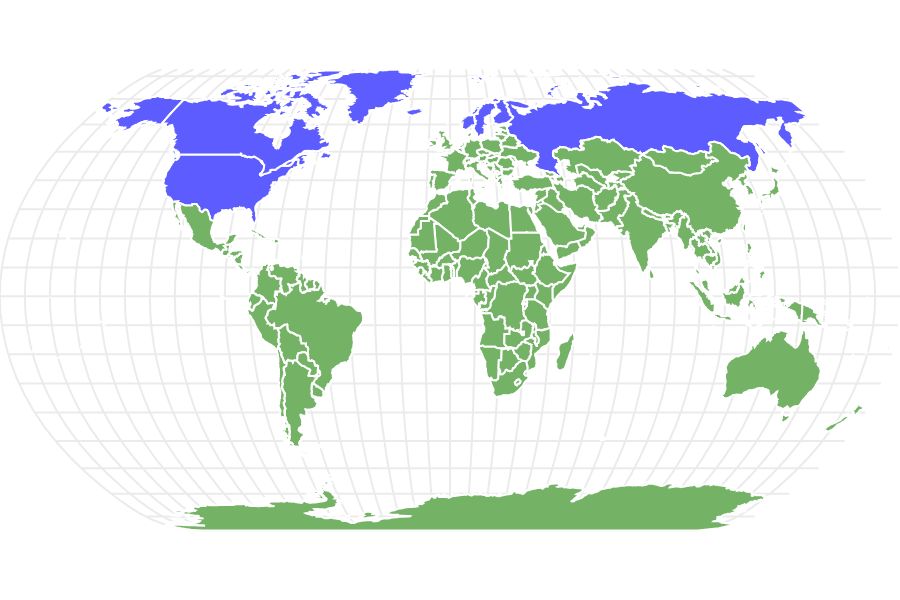Arctic Fox
Vulpes lagopus
Extremely thick winter fur!
Advertisement
Arctic Fox Scientific Classification
- Kingdom
- Animalia
- Phylum
- Chordata
- Class
- Mammalia
- Order
- Carnivora
- Family
- Canidae
- Genus
- Vulpes
- Scientific Name
- Vulpes lagopus
Read our Complete Guide to Classification of Animals.
Arctic Fox Conservation Status
Arctic Fox Facts
- Main Prey
- Lemmings, voles, hares, other small rodents, berries, insects
- Name Of Young
- kit
- Distinctive Feature
- Thick fur that changes colour with season
- Habitat
- Polar forest regions
- Predators
- Snowy Owl, Wolf, Polar Bear
- Diet
- Carnivore
- Average Litter Size
- 5
- Lifestyle
- Solitary
- Favorite Food
- Lemmings
- Type
- Mammal
- Slogan
- Extremely thick winter fur!
View all of the Arctic Fox images!
“Arctic Foxes Are Iceland’s Only Native Mammal”
Arctic foxes (often misspelled as artic fox or artic foxes) are small, adorable animals and have natural adaptations protecting them from predators and frigid temperatures. According to fossils, Arctic foxes got their start in Tibet during the Pliocene Epoch, 2.6 million years ago, then spread to North America and Eurasia by migrating over ice-land bridges. The species is Iceland’s only native mammal, and while hundreds of thousands currently roam around the Arctic Circle, climate change threatens to decimate populations in the coming years.
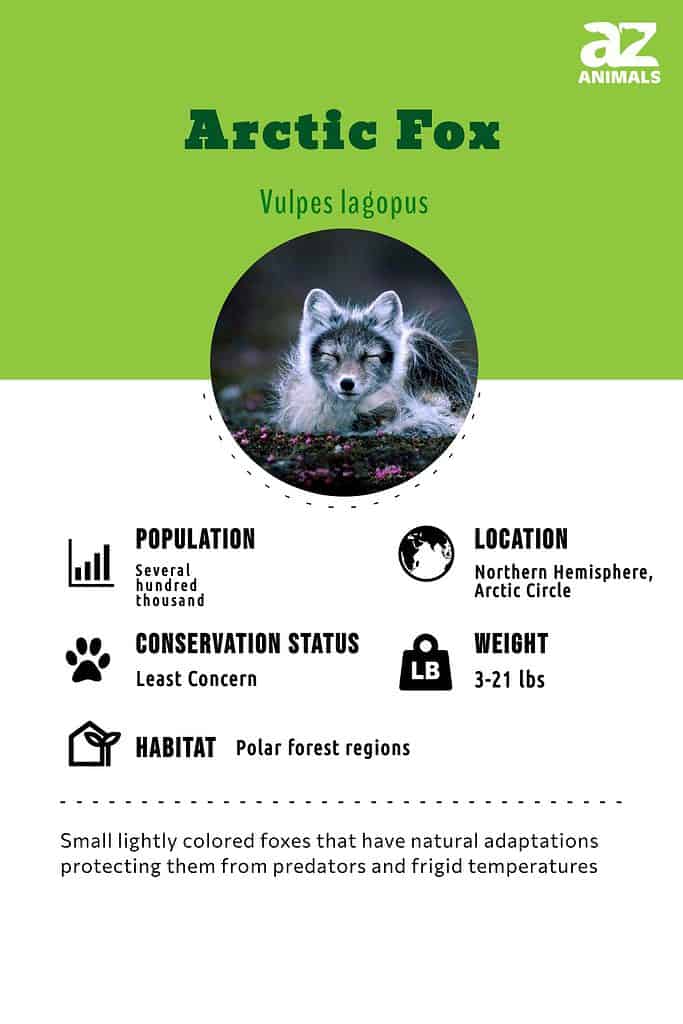
Incredible Arctic Fox Facts!
- They are burrow dwellers that occupy elaborate dens, some of which are centuries old!
- The species diverged from domesticated dogs 12 million years ago.
- Arctic foxes are the main carriers of the Arctic rabies virus.
- Individuals of the species can trek up to 96.3 miles (155 kilometers) in a single day!
- These foxes are smart, curious, and fast! When avoiding predators and hunting prey, they can sprint up to 50 kilometers per hour.
Want to discover more facts? Make sure to read ‘10 Incredible Arctic Fox Facts‘ to learn more about these amazing animals.
Scientific Name
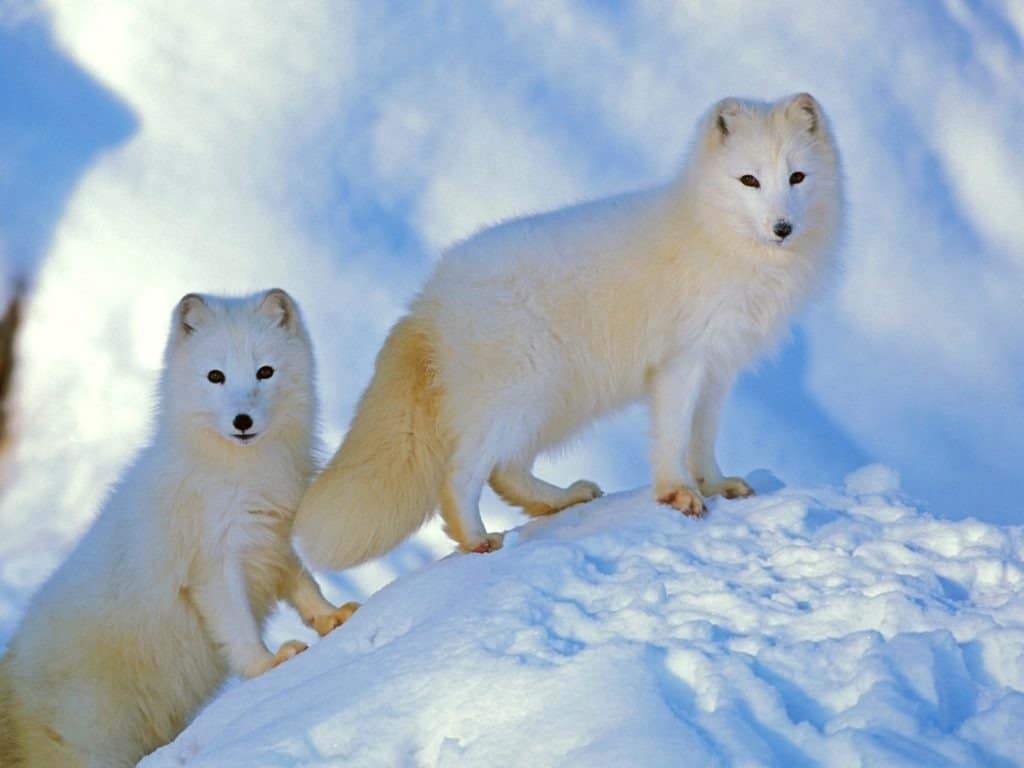
The scientific name for the Arctic Fox is
Vulpes lagopus©rokopix/Shutterstock.com
The scientific name for these foxes is Vulpes lagopus — which has Ancient Greek and Latin roots. “Vulpes” is the Latin word for “fox,” and lagopus comes from two Ancient Greek words, lagōs, which means “hare,” and pous, which means “foot.” Together the scientific name translates to “hairy-footed fox.”
In 1758, the father of taxonomy, Carl Linneaus, assigned the species two names: Alopex lagopus and Canis lagopus. Since then, scientists have gathered more genetic information and changed it to Vulpes lagopus.
Arctic foxes are also known as white foxes, polar foxes, and snow foxes. Adult males are called “dogs” and females “vixens.” A group of these foxes is known as either a “skulk” or a “leash.”
Tiriganiarjuk is the Inuit word for Arctic fox, which translates to “the little white one.” In other native languages, the species name translates to “the one who walks a lot.”
Appearance and Behavior
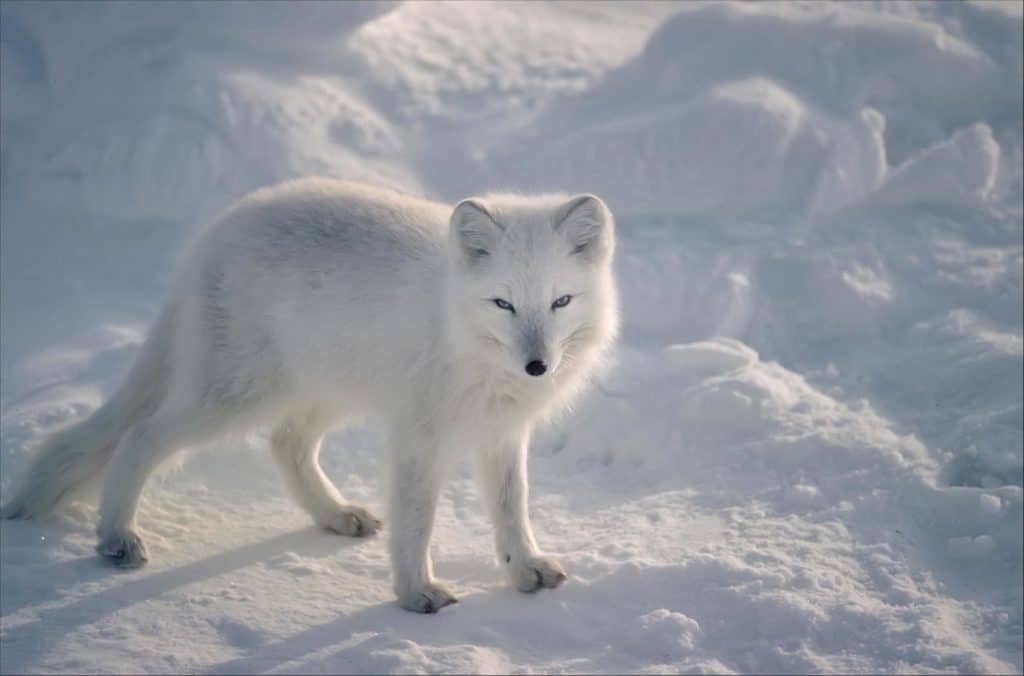
Arctic foxes have two key colors in their coats: white and blue.
©outdoorsman/Shutterstock.com
Appearance
The male foxes are slightly larger than females of the species. Large individuals are about the size of Jack Russell terriers; smaller ones are the size of chihuahuas.
| Gender | Average Size | Average Height | Average Weight |
|---|---|---|---|
| Female | 20 inches (52 centimeters) | 9.8 to 11.8 inches (25 to 30 centimeters) | 3.1 to 7.1 pounds (1.4 to 3.2 kilograms) |
| Male | 22 inches (55 centimeters) | 9.8 to 11.8 inches (25 to 30 centimeters) | 7.1 to 20.7 pounds (3.2 to 9.4 kilograms) |
Adaptations That Keep Arctic Foxes Warm
Arctic foxes are animals that are present in two color morphs: white and blue. Ninety-nine percent have the white color morph, meaning their fur is white in winter to blend in with the ice and brown in summer to camouflage with cliffs and rocks. The other one percent — mainly in coastal regions — has the blue morph, meaning they have rock blue-ice coloring in the winter and gray-blue in the summer. These color adaptations help them blend into the environment and evade predators.
Both male and female fox tails — aka “brushes” — measure about 12 inches (30 centimeters). More than just a balance aid, they also serve as blankets. It’s one of several adaptations that allow them to survive sub-zero winters. In addition to their long and warm tails, Arctic foxes also have fur-covered paws that work to keep their bodies toasty warm in the winter.
Thick ears, short muzzles, and multilayer pelage also help Arctic foxes survive freezing environments. Their fur is the warmest of any mammal, and their compact bodies optimally conserve heat. Better yet, they can separately control their paw and core temperatures — which makes for comfortable ice walks!
Ideally engineered to withstand harsh climates, they don’t start shivering until the mercury reaches -94 °F (-70 °C). Learn about the toughest animals in the world here.
Behavior
Arctic foxes are animals that can be active around the clock. During the autumn and winter, they lead more solitary lives and reduce activity to preserve insular fat — but they don’t hibernate. In the spring and summer, these foxes convene to live as families, breed, and raise pups.
When not out hunting, foraging, or teaching pups survival tactics, arctic foxes hang out in gigantic, maze-like dens that typically face southward to best harness the sun’s heat. In warm weather, they sleep outside; during the harsh winters, they slumber inside.
Arctic fox dens are constructed for maximum predator evasion and pup protection. Some are so complex that they have more than 100 entrances! Appreciative of their ancestors’ burrowing efforts, the foxes preserve dens instead of building new complexes every year. In fact, some are hundreds of years old!

Pair of Arctic Foxes standing together on snowhill, alert
©rokopix/Shutterstock.com
Habitat

Polar Regions of the Arctic Circle is where Arctic Foxes can be found
©Orcaborealis / CC BY-SA 3.0 – License
Where can you find Arctic foxes? The species populates the Northern Hemisphere’s Arctic Circle where summer temperatures range between 14 and 86 °F (-10 and 30 °C), and the winter thermometer hovers around -30° F (-34°C).
Communities are scattered throughout the treeless tundra regions of North America, Asia, Europe, Greenland, and Iceland, with most populations living in pack-ice areas. However, some Canadian Arctic foxes inhabit boreal forests filled with pines and spruces.
To date, scientists have identified four subspecies.
| Subspecies Location | Arctic Fox Subspecies Scientific Name |
|---|---|
| Bering Islands Arctic fox | V.I. beringensis |
| Greenland Arctic fox | V.I. foragoapusis |
| Iceland Arctic fox | V.I. fuliginosus |
| Pribilof Islands Arctic fox | V.I. pribilofensis |
The Evolution and Origins
The arctic fox was thought to originally evolve in Europe however, the ice sheets expanded during a glacial period that happened on Earth about 2.6 million years ago. With that said, fossil evidence now suggests that the animal may have pre-adapted to live in a harsh, freezing environment. That is one reason the mammal was able to survive.
A jawbone was discovered while hiking up and down Tibetan mountains about 4,730 meters above sea level. That was the first discovery fossil that was unearthed that did not match any known fox species. Not only did the bone prove that arctic foxes existed in the area around that time, but also proved that they were mostly meat eaters.
Arctic Fox Diet: Prey
What do Arctic foxes eat? Their meals of choice are lemmings, voles, hares, and other small rodents. When their preferred meat is unavailable, Arctic foxes chow down on fish, snow geese eggs, ptarmigan, grouse, puffins, ringed seal pups, and reindeer. When things are truly scarce, they turn to berries and seaweed.
And yes, when faced with starvation, they eat their own feces!
During the summer and autumn, aided by their sharp smell and sight senses, they hunt prey. They can sniff out seal lairs from over a mile away and hear lemmings burrowing several inches below ground. On a good day, a family of foxes can down dozens of rodents. When lucky enough to have a surplus of food, the foxes bury it for a rainy day.
But life gets a lot tougher in the winter. Meat is much harder to find, and vegetation is dormant. To survive, these foxes stalk polar bears and dine on their scraps. But it’s a dangerous endeavor because polar bears prey on foxes!
Predators and Threats
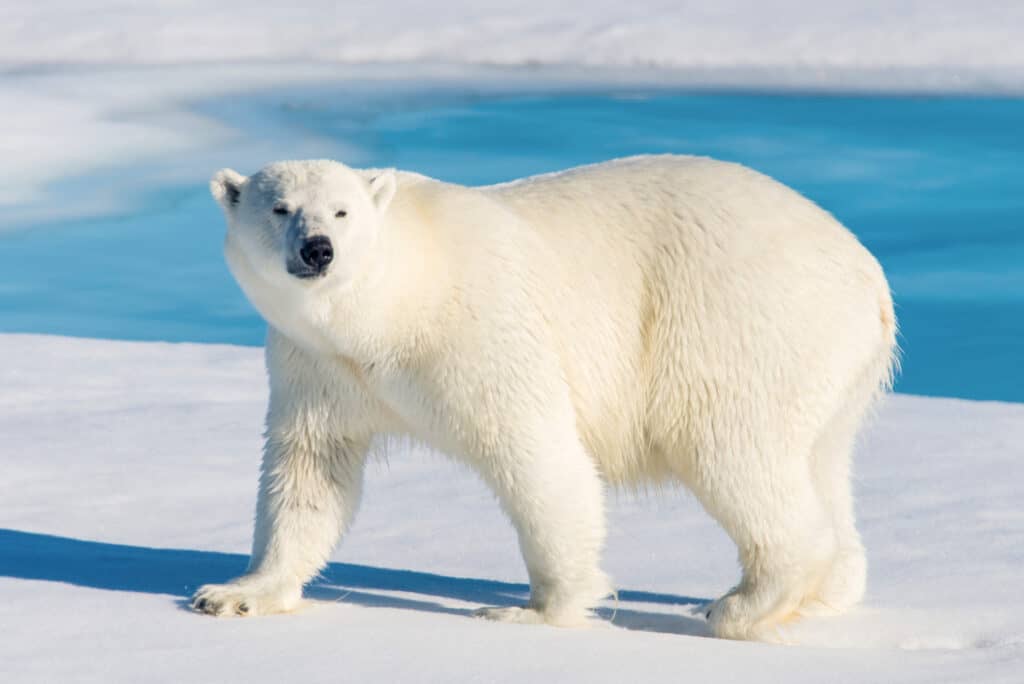
Polar bears are one of the main predators of Arctic foxes
©iStock.com/Alexey_Seafarer
What animals prey on Arctic foxes? The species’ main predators are polar bears, wolves, wolverines, brown bears, red foxes, and humans. They also must keep an eye out for fast golden eagles, bald eagles, and snowy owls that swoop down and snatch baby foxes.
But these days, natural predators aren’t their worst threat — climate change and offshore drilling are fast becoming the species’ main nemesis. Arctic temperatures are skyrocketing — which leads to reduced sea ice and rising sea levels. Add some destructive oil extraction off the coast, and it’s an ecological tinderbox on the brink of explosion.
Plus, even though the foxes are still plentiful in most regions, other animals are dying off and creating food shortages. Moreover, due to rapidly melting ice, their lighter coats are becoming a liability, not an advantage. To complete the perfect storm, increasingly, these foxes are losing ground to the larger red fox.
Native Arctic peoples still retain the right to hunt polar foxes for sustenance, but commercial hunting of the species is now off-limits.
Reproduction, Babies, and Lifespan
Reproduction
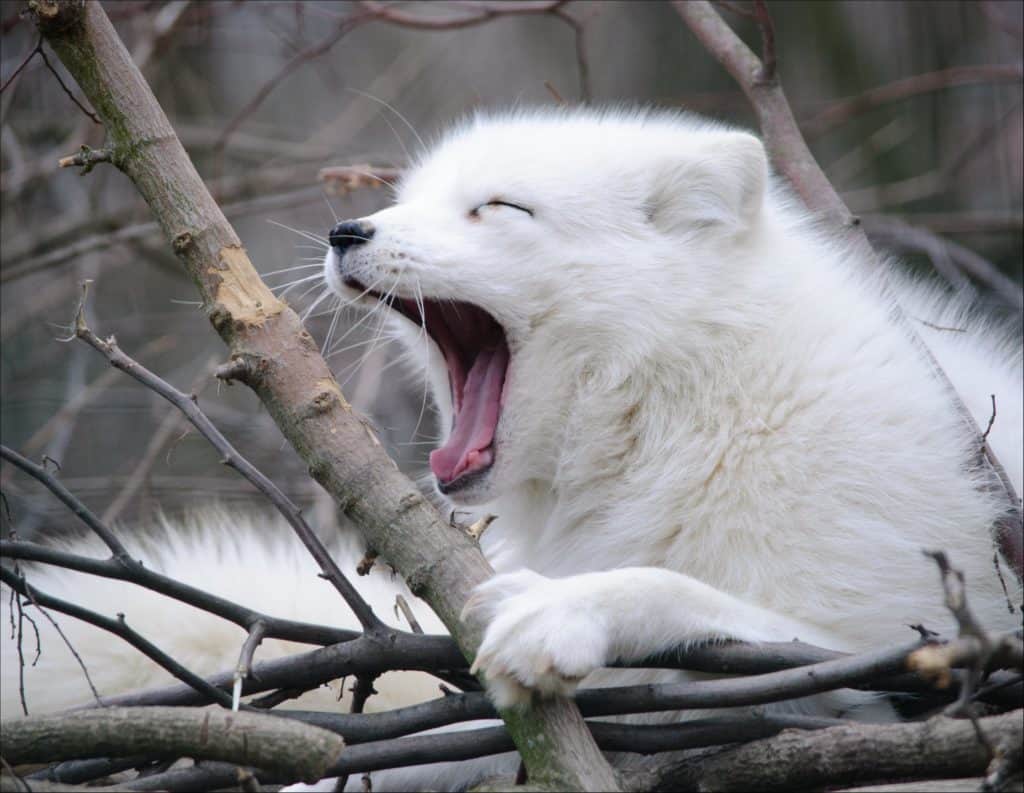
A young arctic fox yawning in a pile of sticks
©Blanka Berankova/Shutterstock.com
When the snow melts and the sun comes out of hibernation, these foxes gather for the mating season between late February and May. In food-insecure populations, these foxes form monogamous pairs for the season. In communities where food is abundant, they’re more promiscuous and form complex social structures where multiple individuals look after each others’ newborns.
Typically, inland populations are more monogamous than coastal ones — the exception is Icelandic Arctic foxes. The subspecies exhibit strong familial ties, and offspring will often stick around their parents’ territories for a long time, even in times of famine when food can be found elsewhere.
Females gestate for about 52 days and give birth between April and July to litters ranging between five and 25, the most of all carnivore species.
Babies
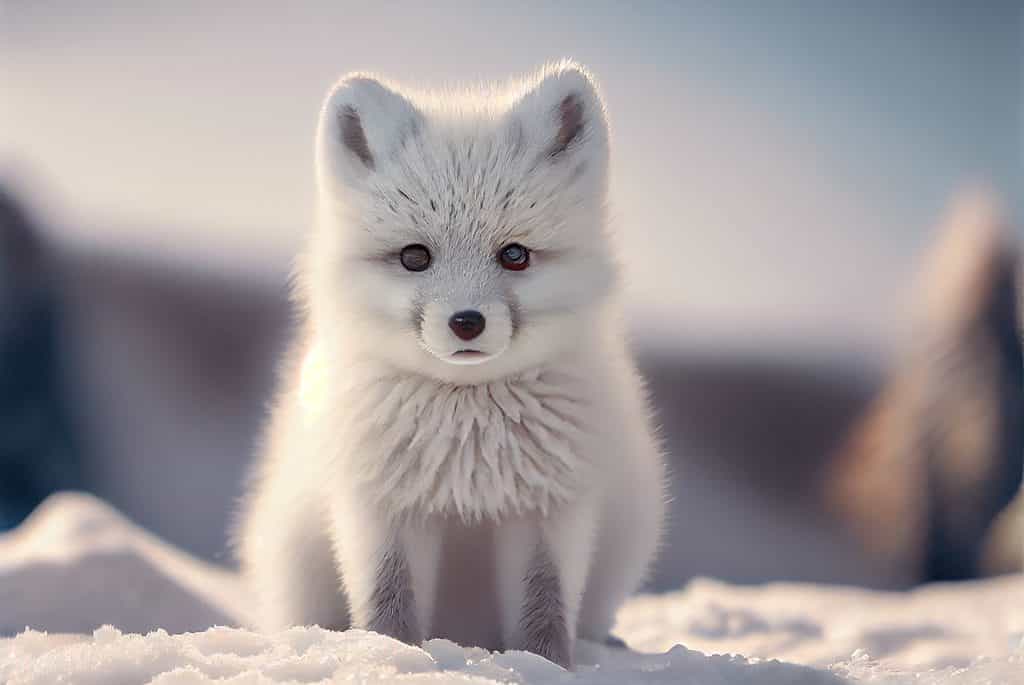
Baby Arctic fox (Vulpes lagopus) in snow habitat, winter landscape, Svalbard, Norway
©bhavdip12/Shutterstock.com
Baby Arctic foxes are called “kits.” They’re born with dark fur and enjoy the care and attention of both parents. Kits nurse for about 45 days and begin to emerge from the den after three weeks. By week nine, the pups are usually ready to make it independently. At nine months, they’re sexually mature and ready to start mating.
Lifespan
Arctic foxes don’t live long. Though fast, in the wild most become bear prey between three and six years old. But even in captivity, they usually only make it to ten or eleven.
Population

There are a few hundred thousand of Arctic Foxes left in the wild
©iStock.com/MikeLane45
Currently, several hundred thousand of these foxes live in the wild, and the International Union for the Conservation of Nature categorizes the species under Least Concern on its Red List. But that doesn’t tell the whole story.
Climate change is rapidly damaging Arctic fox habitats, and if things don’t change over the next decade, the species could become a global warming casualty.
Already, the Scandinavian population is Endangered. Less than 200 individuals remain, and severe inbreeding further threatens its survival. Conservationists are in the process of introducing new individuals of breeding age into the area, but will their efforts work?
It remains to be seen.
Arctic Foxes In United States’ Zoos

Arctic Foxes do very well in captivity and can live up to 14 years old if taken care of properly
©Marcel Burkhard / Creative Commons – License
Below is a partial list of U.S. zoos with these foxes.
Detroit Zoo: Moxie and Alex, two females, live in the Detroit Zoo’s state-of-the-art Arctic Ring of Life habitat.
San Diego Zoo: Despite being in sunny California, the San Diego Zoo is home to two of these foxes named Isiq and Kaniq that live in the Polar Bear Plunge enclosure.
Stone Zoo: Stone Zoo, in Stoneham, Massachusetts, cares for two fast Arctic foxes that love to whiz around their enclosure.
Point Defiance Zoo: Point Defiance Zoo and Aquarium in Tacoma, Washington maintains a large exhibit for two of them.
North Carolina Zoo: The Rocky Coast exhibit at the North Carolina Zoo is home to two of the foxes.
Other stateside zoos with these foxes include:
- Cincinnati Zoo and Botanical Garden in Ohio
- Potter Park Zoo in Michigan
- Buffalo Zoo in New York
- Columbus Zoo in Ohio
- Tulsa Zoo in Oklahoma
- Wildwood Zoo in Wisconsin
- Racine Zoo in Wisconsin
- Austin Zoo in Texas
Arctic Fox FAQs (Frequently Asked Questions)
Are Arctic Foxes Carnivores, Herbivores, or Omnivores?
Arctic foxes are omnivores, meaning they eat both meat and plants.
Are Arctic Foxes Dangerous to Humans?
Arctic foxes are small and fast — but not a massive threat to humans. However, always be cautious around wild animals and keep your distance if not trained to interact with them.
What Eats Arctic Foxes?
Arctix fox predators include polar bears, wolves, wolverines, brown bears, and red foxes. They also have to keep an eye out for eagles and snowy owls.
What Do Arctic Foxes Eat?
Arctic foxes prey on lemmings, voles, hares, fish, snow geese eggs, ptarmigan, grouse, puffins, ringed seal pups, reindeer, berries, and seaweed. In times of extreme famine, Arctic foxes will even eat their own feces!
Where Does the Arctic Fox Live?
Arctic foxes live in tundra and taiga regions of Asia, Europe, Greenland, Iceland, and North America.
How Big Is an Arctic Fox?
Small Arctic foxes are about half the size of a school ruler; larger ones are about the size of two and a half new pencils.
How Many Arctic Foxes Are Left?
Hundreds of thousands of Arctic foxes currently roam the Earth. But due to climate change and reckless oil drilling, their numbers are declining. Populations in Norway, Sweden, and Finland are already Endangered.
What Kingdom do Arctic Foxes belong to?
Arctic Foxes belong to the Kingdom Animalia.
What phylum do Arctic Foxes belong to?
Arctic Foxes belong to the phylum Chordata.
What class do Arctic Foxes belong to?
Arctic Foxes belong to the class Mammalia.
What family do Arctic Foxes belong to?
Arctic Foxes belong to the family Canidae.
What order do Arctic Foxes belong to?
Arctic Foxes belong to the order Carnivora.
What genus do Arctic Foxes belong to?
Arctic Foxes belong to the genus Vulpes.
What type of covering do Arctic Foxes have?
Arctic Foxes are covered in Fur.
What are some distinguishing features of Arctic Foxes?
Arctic Foxes have thick fur that changes color with the seasons.
What is the average litter size for an Arctic Fox?
The average litter size for an Arctic Fox is 5.
What is an interesting fact about Arctic Foxes?
Arctic Foxes have extremely thick winter fur!
What is the scientific name for the Arctic Fox?
The scientific name for the Arctic Fox is Vulpes lagopus.
What is the lifespan of an Arctic Fox?
Arctic Foxes can live for 7 to 10 years.
What is a baby Arctic Fox called?
A baby Arctic Fox is called a kit.
How fast is an Arctic Fox?
An Arctic Fox can travel at speeds of up to 30 miles per hour.
How to say Arctic Fox in ...
Thank you for reading! Have some feedback for us? Contact the AZ Animals editorial team.
Sources
- David Burnie, Dorling Kindersley (2011) Animal, The Definitive Visual Guide To The World's Wildlife
- Tom Jackson, Lorenz Books (2007) The World Encyclopedia Of Animals
- David Burnie, Kingfisher (2011) The Kingfisher Animal Encyclopedia
- Richard Mackay, University of California Press (2009) The Atlas Of Endangered Species
- David Burnie, Dorling Kindersley (2008) Illustrated Encyclopedia Of Animals
- Dorling Kindersley (2006) Dorling Kindersley Encyclopedia Of Animals
- David W. Macdonald, Oxford University Press (2010) The Encyclopedia Of Mammals
- Qui, J. (2014) Origins of Arctic fox traced back to Tibet - https://www.nature.com/news/origins-of-arctic-fox-traced-back-to-tibet-1.15398
- Icelandic Institute of Natural History. Mammals. Náttúrufræðistofnun Íslands, Available here: https://en.ni.is/fauna/mammals
- Center for Biological Diversity. ARCTIC FOX (Alopex lagopus). Arctic fox, Available here: https://www.biologicaldiversity.org/programs/climate_law_institute/the_arctic_meltdown/slideshow_text/arctic_fox.html
- Brears, R. C (1970) Arctic Foxes: Constant Gardeners of the Arctic. Oceanwide Expeditions. https://oceanwide-expeditions.com/blog/arctic-foxes-the-constant-gardeners-of-the-arctic
- Matias, D. (2019) Arctic Fox Sets Record In Walking From Norway To Canada. NPR. https://www.npr.org/2019/07/02/737993673/arctic-fox-sets-record-in-walking-from-norway-to-canada
- Canada's Arctic. Tiriganiarjuk — Arctic Fox . Anirniliit - those which breathe, Available here: http://www.arctic.uoguelph.ca/cpl/Traditional/traditional/animals/fox.htm
- Bragg, R. (1970) Which Arctic Animal Has the Warmest Fur? Animals.mom.com. https://animals.mom.com/arctic-animal-warmest-fur-11195.html
- Noren, K; et al (1970) "From monogamy to complexity: social organization of arctic foxes (Vulpes lagopus) in contrasting ecosystems". Canadian Journal of Zoology. 90 (9): 1102–1116

